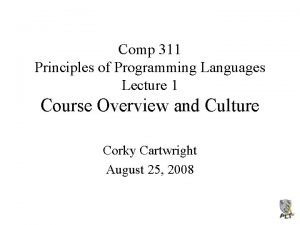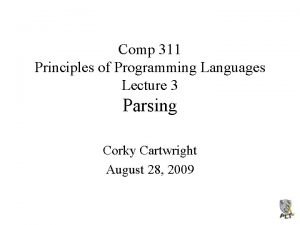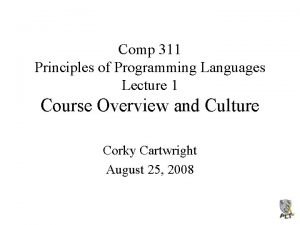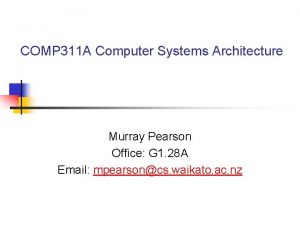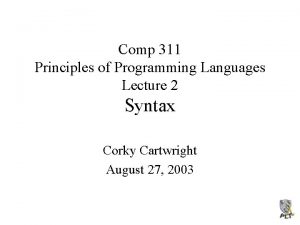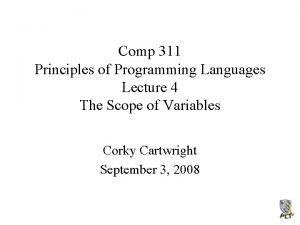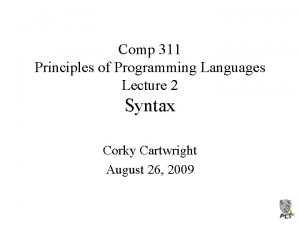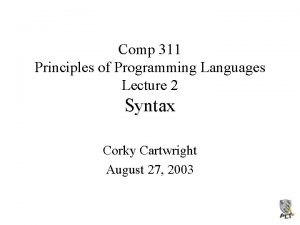Comp 311 Principles of Programming Languages Lecture 3







- Slides: 7

Comp 311 Principles of Programming Languages Lecture 3 Parsing Corky Cartwright August 28, 2009

Top Down Parsing • What is a context-free grammar (CFG)? A recursive definition of a set of strings; it is identical in format to the data definitions used in Comp 211 except for the fact that it defines sets of strings (using concatenation) rather than sets of trees (objects/structs) using tree construction. The root symbol of a grammar generates the language of he grammar. In other words, it designates the syntax of complete programs. • Example. The language of expressions generated by <expr> : : = <term> | <term> + <expr> <term> : : = <number> | <variable> | ( <expr> ) • Some sample strings generated by this CFG 5 5+10+7 (5+10)+7 • What is the fundamental difference between generating strings and generating trees? – The derivation of a generated tree is manifest in the structure of the tree. – The derivation of a generated string is not manifest in the structure of the string; it must be reconstructed by the parsing process. The reconstruction may be amibiguous.

Top Down Parsing cont. • Data definition corresponding to sample grammar: Expr = Expr + Expr | Number | Variable • Why is the data definition simpler? (Why did we introduce the syntactic category <term> in the CFG? ) • Consider the following example: 5+10+7 • Are strings a good data representation for programs? • Why do we use string representations for programs?

Parsing algorithms • Top-down (predictive) parsing: use k token lookahead to determine next syntactic category. • Simplest description uses syntax diagrams expr: term: + expr

Key Idea in Top Down Parsing • Use k token look-ahead to determine which direction to go at a branch point in the current syntax diagram. • Example: 5+10 – Start parsing by reading first token 5 and matching the syntax diagram for expr – Must recognize a term; invoke rule (diagram) for term – Select the number branch (path) based on current token 5 – Digest the current token to match number and read next token +; return from term back to expr – Select the + branch in expr diagram based on current token – Digest the current token to match + and read the next token 10 – Must recognize an expr; invoke rule (diagram) for expr – Must recognize a term; invoke rule (diagram) for term – Select the number branch based on current token 10 – Digest the current token to match number and read next token EOF – Return from term; return from expr

Designing Grammars for Top-Down Parsing • Many different grammars generate the same language (set of strings): • Requirement for any efficient parsing technique: determinism (non-ambiguity) • For deterministic top-down parsing, we must design the grammar so that we can always tell what rule to use next starting from the root of the parse tree by looking ahead some small number (k) of tokens (formalized as LL(k) parsing). • For top down parsing – Eliminate left recursion; use right recursion instead – Factor out common prefixes (as in syntax diagrams) – Use iteration in syntax diagrams instead of right recursion where necessary

Other Parsing Methods When we parse a sentence using a CFG, we effectively build a (parse) tree showing how to construct the sentence using the grammar. The root (start) symbol is the root of the tree and the tokens in the input stream are the leaves. Top-down (predictive) parsing is simple and intuitive, but is is not as powerful a deterministic parsing strategy as bottom-up parsing which is much more tedious. Bottom up deterministic parsing is formalized as LR(k) parsing. Every LL(k) grammar is also LR(1) but many LR(1) grammars are not LL(k) for any k. No sane person manually writes a bottom-up parser. In other words, there is no credible bottom-up alternative to recursive descent parsing. Bottom-up parsers are generated using parser-generator tools which until recently were almost universally based on LR(k) parsing (or some bottom-up restriction of LR(k) such as SLR(k) or LALR(k)). But some newer parser generators like javacc are based on LL(k) parsing. In Dr. Java, we have several different parsers including both recursive descent parsers and automatically generated parsers produced by javacc. Why is top-down parsing making inroads among parser generators? Top-down parsing is much easier to understand more amenable to generating
